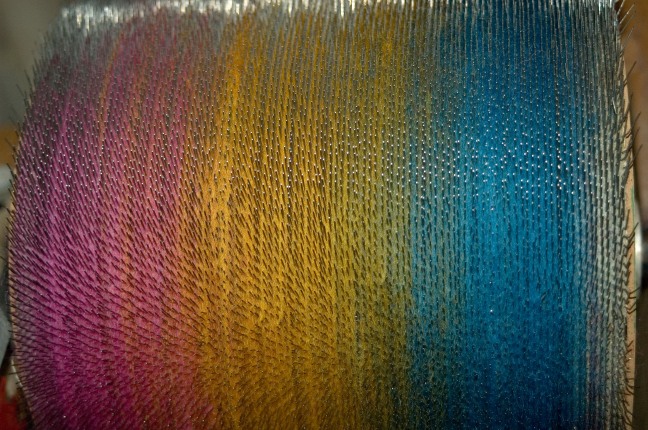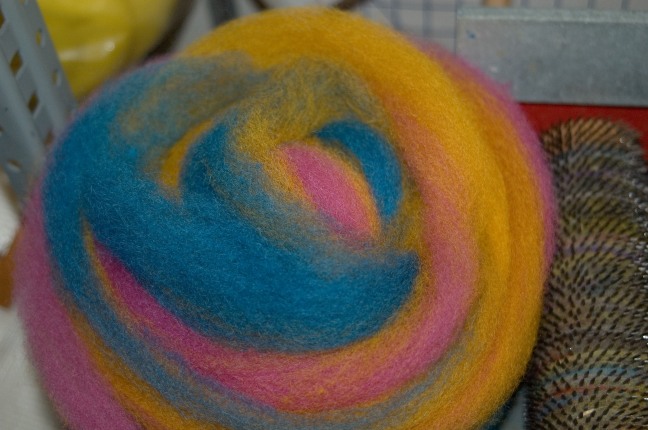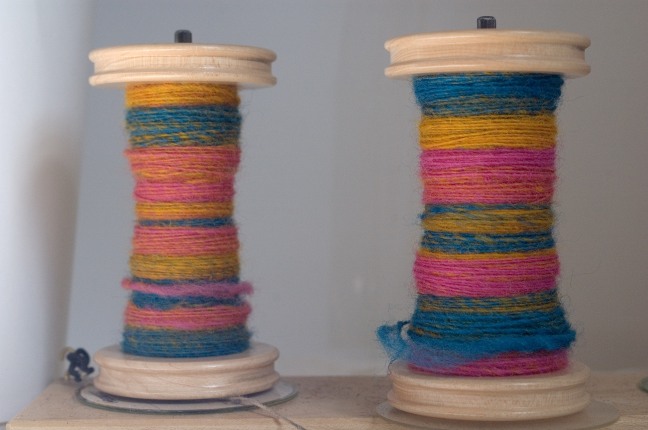In recent years a technique that is starting to be seen more frequently is removing fiber from a drum carder as a roving, rather than as a batt, by pulling the fiber off through a diz. This can be done going back and forth across the width of the carder, or around the circumference. I wanted to see what kind of yarn you got from two of the more common color configurations in smooth batts – layers and stripes.
My first experiment with color management in batts didn’t go well, mostly due to poor fiber choices. I had used equal amounts of fiber by weight, but the middle fiber was bamboo rayon, which was very slippery, and tended to clump together. This is my second attempt, using all the same fiber.
This time I chose turquoise, mustard yellow, and magenta. Because yellow is a high value color, you need more of it in a yarn for it to appear to be there in equal amounts. For my first attempt at a striped batt with these colors I used roughly double the amount of yellow as of turquoise and magenta, with the yellow being the center stripe. My goal was a yarn that had distinct segments of each color, with minimal blending.
My current drum carder is pretty small, so I try not to go much over 35g of fiber on it, usually sticking to 25g for mathematical convenience. I did the same here using 8g each of turquoise and magenta, and 14g of yellow. I split the batt in half, and fed each half back through on its side to make a striped batt. The process went much more smoothly this time, but I found that by only splitting the bat in half I was getting much more color blending at the center than I wanted.
As I dizzed the wool off the carder, I found that the narrowing of the center stripe caused by the aforementioned blending made it difficult to get sections of roving that were mostly yellow. By the time I had stopped picking up blue fibers from one side I had started picking up pink fibers from the other side. I also noticed something that I should have remembered from dyeing combed top – namely that when going back and forth across colors, the color repeats at either end will be twice as long as the color repeats in the center, from changing direction and repeating the same color twice. This needs to be taken into account if you want the colors to be roughly balanced.
I made a second batt, this time with a total of 40g of wool, 10 each of the turquoise and magenta, 20 of yellow. I also split the bat into fourths, rather than in half, when feeding through sideways to make the stripes. This time I had much less blending, and the center section was about twice as wide as the sides.
I still had a fair amount of blending as I dizzed off, but I suspect this effect is strongly related to staple length. With a shorter stapled fiber I would have probably been able to get much longer sections of “clean” yellow.
As you can see, comparing the two singles, the second of these two batts did have much longer segments of color with less blending than the first, and both of them are much better than the attempt with the bamboo!




really cool to see! Thanks for sharing more info about color!
LikeLike
That’s the goal! It can be very frustrating when I’m looking for specific info/techniques and can’t find it. Occasionally I’m in a position to do something about that!
LikeLike